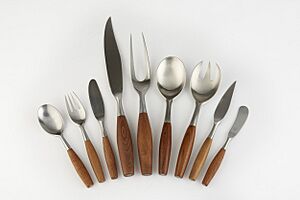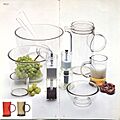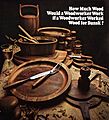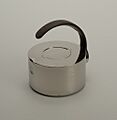Dansk Designs facts for kids

Primary logo
|
|
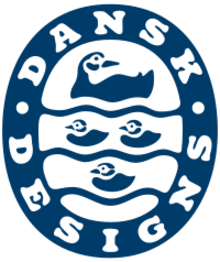
Secondary 1954 'Four Ducks' logo still in use
|
|
|
Formerly
|
Dansk International Designs (1974-2010s) |
|---|---|
| Subsidiary | |
| Industry | Retail |
| Founded | 1954 in Great Neck, New York, United States |
| Founders |
|
| Headquarters | |
|
Area served
|
United States |
| Products | Cookware, serveware, cutlery, home accessories |
| Parent | Food52 (2021-present) |
Dansk Designs, often just called Dansk, is an American company famous for its cool kitchen and home items. They make things like wooden serving dishes, colorful cooking pots, and unique dinnerware. Dansk is based in New York City. This company helped bring the popular "Danish Modern" style into homes across America. The word "Dansk" actually means "Danish" in the Danish language!
Contents
How Dansk Designs Started
In 1954, a couple from America, Martha and Ted Nierenberg, were on their honeymoon in Europe. They were looking for great designs to start a new business back home in the U.S. They visited different countries, but didn't find anything they loved until they went to Copenhagen, Denmark.
Discovering a Unique Design
At a museum in Copenhagen, they saw a very unusual set of cutlery (forks, spoons, knives). It was made from a mix of wood and stainless steel. A young artist named Jens Quistgaard had created it. The Nierenbergs were so impressed that they just had to meet him!
Quistgaard was very busy in his studio, which was covered in plaster and dust. He didn't think his special cutlery could be made in large numbers. But the Nierenbergs had seen new ways of making things in Germany. They convinced him that they knew how to mass-produce his amazing design. This led to Dansk Designs' very first product: the Fjord flatware. It became one of their most popular items and is still loved today.
Growing the Company
The Nierenbergs started Dansk that same year in their home garage in Great Neck, New York. Jens Quistgaard became their "Chief Designer" and worked with them for 30 years! Ted Nierenberg wanted to call the company "Danish Design." But Quistgaard suggested "Dansk Designs" because "Dansk" sounded more authentic, like using a Russian name for vodka.
In 1955, Quistgaard designed a new line of colorful cooking pots called 'Købenstyle'. Ted Nierenberg quickly got orders from stores all over the U.S., and the business really took off. By 1958, Dansk was selling many different items. These included stainless steel flatware, porcelain dishes, stoneware casseroles, and wooden items like stools and ice buckets.
Dansk's Success and Changes
In the 1960s, Dansk moved its main office to Mount Kisco, New York to make more space. The New York Times newspaper said that Dansk was "creating a stir" with its popular home accessories. Over the years, Dansk worked with other talented designers like Arne Jacobsen and Vivianna Torun Bülow-Hübe. Dansk became one of the most successful brands to bring Danish Modern designs into American kitchens and dining rooms. By the early 1980s, Quistgaard had created over 4,000 different designs for Dansk!
Over time, Dansk changed owners several times. In 2020, during the COVID-19 pandemic, the company that owned Dansk had to close its factories and stores. But in 2021, a company called Food52 bought Dansk. They plan to bring the brand back to life and moved its headquarters back to New York City.
How Dansk Designs Are Made
Dansk used clever ways to make Jens Quistgaard's unique designs for many people to buy. This was especially true for his metal and wood pieces, which often had cool, flowing shapes.
Smart Production Techniques
Instead of carving wood from one big, expensive piece, Dansk used a "staving technique." This meant connecting smaller wood blocks together with a special glue. This method made the wooden items stronger and less likely to crack when washed. It also allowed Quistgaard to choose how the wood grain looked in the final design.
The 'Købenstyle' cooking pots were made from thin, enameled steel. They had smooth, sculpted shapes that usually only heavy cast iron pots had. The special curved handles on Købenstyle pots were attached with tiny welds. This helped keep the handles from getting too hot, so you could often pick up the pot without needing oven mitts! The lids of these pots could even be used as a trivet (a mat to protect your table) when serving food.
Famous Designs and Collections
Dansk designs are known for their artistic beauty. You can find examples of their work in famous museums around the world. These include the Metropolitan Museum of Art and the Museum of Modern Art in New York, and even The Louvre in Paris, France!
At first, Dansk products were made in Denmark or Germany. Later, production moved to France, and then to countries like Portugal, Finland, Norway, Korea, and Japan. Today, many new Dansk items are made in Thailand, Malaysia, China, and India.
It's a bit tricky to know exactly how many designs Dansk has made. Because the company changed owners and moved so many times, some of its old design records were lost. Also, Jens Quistgaard often changed his designs even after they started being made. Many of his pieces, like the peppermills, didn't even have names, just product numbers. So, it's still a mystery how many different items Dansk has designed and produced over the years!
Images for kids


